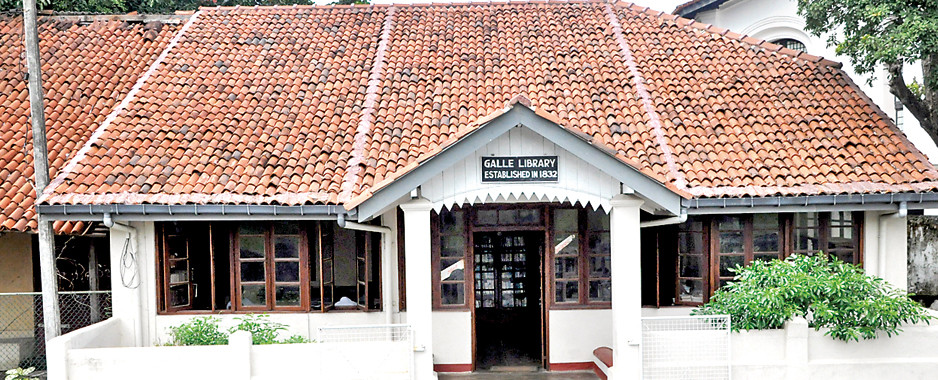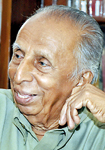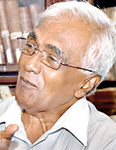Leafing through the story of an old library
View(s):132 years old and housed in the historic Galle Fort, the Galle Library has a rich tradition that still continues at its own pace, says Duvindi Illankoon
“As for the Galle Library, it was the haunt of lawyers stretched out on loungers, whiling away the morning and afternoons..” Those Long Afternoons: Childhood in Colonial Ceylon,– E.F.C. Ludowyk
Inside the crumbling edifices of the Galle Fort are a treasure trove of memories and some of the country’s most historic monuments. The fort is over four centuries old so it makes sense that it is home to the Galle Library, Sri Lanka’s oldest standing records collection and reading room situated in the vicinity of the Galle Clock Tower.

The Galle Library: Well preserved both within and without. Pix by Indika Handuwala
The front room serves as a lounging area for those perusing newspapers-it’s a weekday, but they seem to be in no hurry, thumbing through the broadsheets with a diligent eye.
Through another door is a large room with bookcases stretching all the way from ceiling to floor. In the midst of the towering bookcases is a large round table of sorts that used to reverberate with the pounding of some influential fists caught up in heated debate, but now serves as a quiet reading area. The library is relatively small and only houses 7000 books but as librarian Mr. S. Abeywickrama puts it, “these are some of the finest publications you will ever come across.”
“We’re not funded by the government,” says. K.L. Somaratne, the Secretary of the newly appointed committee of the Galle Library. “It all comes out of our pockets and the fundraisers we organise. We organised The Galle Season for two successive years and raised a substantial amount of funds for the upkeep of the building.” Together with Vice President A.W.M. Aiyoob and Librarian Mr. Abeywickrama, Mr. Somaratne settles down to tell us the story behind this great institution over a cup of tea.
The Galle Library had its beginnings in 1932, exactly 180 years ago. Established as the Galle Reading Room by the Ceylon Rifles Regiment, it was run by a three member committee and mostly served the men in uniform. According to the Ceylon Almanac and Compendium of Useful Information published in 1845, the reading room was renamed as the Galle Library under the then Governor of Ceylon. The library continued to serve the Rifles Regiment until it was abolished in 1879.
 Librarian S. Abeywickrama |
 Secretary K.L. Somaratne |
 Vice President A.W.M. Aiyoob |
The Galle Library earned its place in the annals of our history once it began serving the people of the South.
The first Committee to run the library was elected in 1871, with Dr. Peter Anthonisz as President. Since then, many a great luminary has been elected as an office bearer of the institution; Dr. C.W.W. Kannangara, Judge F.J. Roberts, Judge Paul E. Peiris, C.H. Wickramanayake to name a few.
During Mr. Wickramanayake’s time from 1924-1930, the library underwent major renovation (and modernisation!), finally gaining access to the electricity supply. A Sinhalese literary section was added to the already extensive collection in 1935.
Today, the library houses an extraordinary collection of published works. Books on mountaineering, sailing and fishing compete for space amongst works on religion and philosophy, the fine arts, architecture, painting, music, theatre, literature, photography, pets and everything else. Many are hardly relevant to modern times yet so beautifully written that one can’t help but leaf through the pages of painstakingly illustrated descriptions. ‘The Strangling of Persia’, a 1912 publication by Morgan Schuster is practically calling out to be picked up- and a visiting foreign couple who’ve obtained temporary membership for the day do.
The oldest work in here is ‘An Account of the Island of Ceylon’ by Captain Robert Percival, published in 1803. “Even before the British took over Sri Lanka,” enthuses a proud Mr. Abeywickrama. “We believe that this is the only, if not one of the few copies available in Sri Lanka.” Captain Percival came over to the island with His Majesty’s 19th Regiment of Foot and was immediately caught up in the romance of the land and determined to delve further into Ceylon’s history. The result was a 400 plus-page account of the country and its people, a rare copy of which is housed at the Galle Library.
Many of the books are donations made from its inception in 1832. Its members would always be bringing in large volumes for they knew that these works would be well taken care of. “The custom of the old times would be for members to show their support by either cash donations or books. The Galle Fort was home to many intellectuals and they would donate their books once they were finished with them, or if it was a particularly interesting one that they thought the other members would enjoy. This custom continues to live on now,” smiles Mr. Abeywickrama.
The lending and reference of these works are closely monitored by a 31-member library committee, whose commitment and dedication to the library is a story of its own. Seven of these office bearers form a select committee that makes decisions about bestowing the privilege of using the library on members. “Not everyone is granted a membership,” says Mr. Somaratne. “The selection process is very closely monitored, as we often get loiterers who are just looking for a space to while away time. To be a permanent member, you must be from the Galle District. If you’re a visitor to the Fort and wish to make use of the library for a short time, you can pay a temporary membership fee of Rs. 1000 and obtain it.”
The selection process is worthy of mention. Your name will be read out at a committee meeting, and then each member will be given a black ball and a white ball (in the style of lotteries). They will cast their vote anonymously by dropping either a black or white ball into a jar by closing their fists over the ball. The black is a ‘no’ and of course, a white is a ‘yes’. The decision must be unanimous though-if an applicant is given a single ‘black’ vote he will be disqualified.
“It means we never argue later!” grins Mr. Aiyoob. This strict membership process is an effort to preserve the exclusivity and illustrious history that surrounds the Galle Library. “I remember as a child in the 50’s and 60’s, this place used to be a hotspot for intellectuals,” recalls Mr. Aiyoob. “Many government officials lived and worked within the Fort, so afternoons and evenings were often heated debates around this very same table and as a child I would love coming in to listen to them.”
That atmosphere is something they try to preserve even now with monthly talks and forum sessions. They also hope to introduce a new project for schoolchildren to learn English in affiliation with the library.
From teachers to shop owners to aspiring writers, these ladies and gentlemen of the Galle Fort have strong affection towards this old building of theirs; and that, perhaps, is the real story behind the Galle Library.
Follow @timesonlinelk
comments powered by Disqus


















